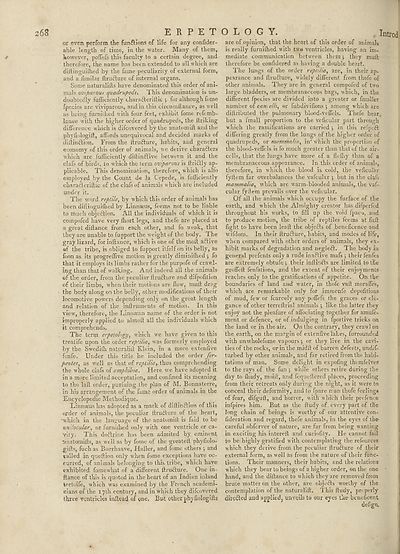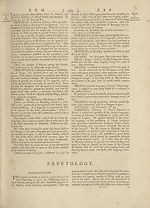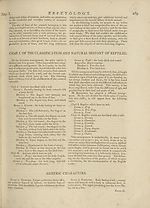Encyclopaedia Britannica, or, a Dictionary of arts, sciences, and miscellaneous literature : enlarged and improved. Illustrated with nearly six hundred engravings > Volume 8, ELE-FOR
(290) Page 268
Download files
Complete book:
Individual page:
Thumbnail gallery: Grid view | List view

268
ERPETOLOGY. Introd
or even perform the functions of life for any confider-
ahle length of time, in the water. Many of them,
however, poffefs this faculty to a certain degree, and
therefore, the name has been extended to all which are
diftinguilhed by the fame peculiarity of external form,
and a fimilar flrufture of internal organs.
Some naturalifts have denominated this order of ani¬
mals oviparous quadrupeds. I his denomination is un¬
doubtedly fufficiently chara&eriftic for although fume
fpecics are viviparous, and in this circumilanee, as well
as being furniihed with four feet, exhibit fome refcmb-
lanee with the higher order of quadrupeds, the linking
difference which is difcovered by the anatomiil and the
phyfiologill, affords unequivocal and decided marks of
diltindlion. From the llrufture, habits, and general
economy of this order of animals, we derive charafters
which are fufficiently diftinftive between it and the
clafi of birds, to which the term oviparous is llridtly ap¬
plicable. This denomination, therefore, which is alio
employed by the Count de la Cepede, is fufficiently
charatleritlic of the clafsof animals which are included
under it.
The word reptile, by which this order of animals has
been diliinguiffied by Linnaeus, feems not to be liable
to much objedlion. All the individuals of which it is
compofed have very ffiort legs, and thefe are placed at
a great dillance from each other, and fo weak, that
they are unable to fupport the weight of the body. The
gray lizard, for inftance, which is one of the moil aflive
af the tribe, is obliged to fupport itfelfon its belly, as
foon as its progreffive motion is greatly diminiffied \ fo
that it employs its limbs rather for the purpofe of crawl¬
ing than that of walking. And indeed all the animals
of the order, from the peculiar ftrufture and difpofition
of their limbs, when their motions are flow, muff drag
the body along on the belly, other modifications of their
locomotive powers depending only on the great length
and relation of the inflrumcnts of motion. In this
view, therefore, the Linn man name of the order is not
improperly applied to almofi all the individuals which
it comprehends.
The term crpelologij, which we have given to this
ireatife upon the order rep!ilia, was formerly employed
by the Swediffi naturalid Klein, in a more extenfive
fenfe. Under this title he included the order fer-
pentes, as well as that of reptiha, thus comprehending
the whole clafs of amphibia. Here we have adopted it
in a more limited acceptation, and confined its meaning
to the laft order, purfuing the plan of M. Bonnaterre,
in his arrangement of the lame order of animals in the
Encyclopedic Methodique.
Linnaeus has adopted as a mark of difti'n£Hon of this
order of animals, the peculiar ftrudture of the heart,
which in the language of the anatomiit is faid to be
unilocular, or furniihed only with one ventricle or ca¬
vity. This doftrine has been admited by eminent
■Unatomills, as well as by fome of the greatetl phyfiolo-
gifts, Rich as Boerhaave, Haller, and fome others ; and
vailed in queftion only when fome exceptions have oc¬
curred, of animals belonging to this, tribe, which have
exhibited fomewhat of a different ftnwffure. One in¬
ftance of this is quoted in the heart of an Indian inland
tortoife, which was examined by the French academi¬
cians of the 17th century, and in which they difcovered
three ventricles inftead of one. But other phyfiologifts
are of opinion, that the heart of this order of animals
is really furnidied with two ventricles, having an im¬
mediate communication between them •, they muft
therefore be confidered as having a double heart.
The lungs of the order reptilia, are, in their ap¬
pearance and ftruifture, widely different from thofe of
other animals. They are in general compofed of two
large bladders, or membranaceous bags, which, in the
different fpecies are divided into a greater or fmaller
number of cancelh, or fubdivifions ; among which are
diftributed the pulmonary blood-veffels. Thefe bear
but a fmall proportion to the veficular part through
which the ramifications are carried ; in this refpeft
differing greatly from the lungs of the higher order of
quadrupeds, or mammalia, in' which the proportion of
the blood-veffels is fo much greater than that of the air-
cells, that the lungs have more of a fleffiy than of a
membranaceous appearance. In this order of animals,
therefore, in which the blood is cold, the veficular
fyftem far overbalances the vafculsr 5 but in the clafs
mammalia, which are warm-blooded animals, the vaf-
cular fyilem prevails over the veficular.
Of all the animals which occupy the furfaee of the
earth, and which the Almighty creator has difperfed
throughout his works, to fill up the void fpaco, and
to produce motion, the tribe of reptiles feems at firft
fight to have been leaft the objecls of beneficence and
wifdom. In their ftru&ure, habits, and modes of life,
when compared with other orders of animals, they ex¬
hibit marks of degradation and negleft. The body in
general prefents only a rude inaftive mafs ; their fenfes
are extremely obtufe ; their inftinfts are limited to the
groffeft fenfations, and the extent of their enjoyments
reaches only to the gratifications of appetite. On the
boundaries of land and water, in thofe vaft moraffes,
which are remarkable only for immenfe depofitious
of mud, few or fcarcely any poffefs the graces or ele¬
gance of other terreftrial animals •, like the latter they
enjoy not the pleafure of affociating together for amule-
merit or defence, or of indulging in fportive tricks on
the land or in the air. On the contrary, they crawl on
the earth, on the margin of extenfive lakes, furrounded
with unwholefome vapours •, or they live in the card-
ties of the rocks, or in the midft of barren deferts, undjf-
turbed by other animals, and far retired from the habi¬
tations of man. Some delight in expofing ihemfelves
to the rays of the fun ; while others retire during the
day to ffiady, moift, and fequeftered places, proceeding
from their retreats only during the night, as it were to
conceal their deformity, and to fpare man thofe feelings
of fear, difguft, and horror, with which their prefence
infpires him. But as the ftudy of. every part of the
long chain of beings is worthy of our attentive con-
fideration and regard, thefe animals, in the eyes of th©'
careful obferver of nature, are far from being wanting
in exciting his intereft and curiofily. He cannot fail
to be highly gratified with contemplating the refources
which they derive from the peculiar ftruflure of their
external form, as well as from the nature of their func¬
tions. Their manners, their habits, and the relations
which they bear to beings of a higher order, on the one
hand, and the diftanee to which they are removed from
brute matter on the other, are objects worthy of the
contemplation of the naturalift. This ftudy, properly
directed and applied, unveils to our eyes the beneficent
defign.
ERPETOLOGY. Introd
or even perform the functions of life for any confider-
ahle length of time, in the water. Many of them,
however, poffefs this faculty to a certain degree, and
therefore, the name has been extended to all which are
diftinguilhed by the fame peculiarity of external form,
and a fimilar flrufture of internal organs.
Some naturalifts have denominated this order of ani¬
mals oviparous quadrupeds. I his denomination is un¬
doubtedly fufficiently chara&eriftic for although fume
fpecics are viviparous, and in this circumilanee, as well
as being furniihed with four feet, exhibit fome refcmb-
lanee with the higher order of quadrupeds, the linking
difference which is difcovered by the anatomiil and the
phyfiologill, affords unequivocal and decided marks of
diltindlion. From the llrufture, habits, and general
economy of this order of animals, we derive charafters
which are fufficiently diftinftive between it and the
clafi of birds, to which the term oviparous is llridtly ap¬
plicable. This denomination, therefore, which is alio
employed by the Count de la Cepede, is fufficiently
charatleritlic of the clafsof animals which are included
under it.
The word reptile, by which this order of animals has
been diliinguiffied by Linnaeus, feems not to be liable
to much objedlion. All the individuals of which it is
compofed have very ffiort legs, and thefe are placed at
a great dillance from each other, and fo weak, that
they are unable to fupport the weight of the body. The
gray lizard, for inftance, which is one of the moil aflive
af the tribe, is obliged to fupport itfelfon its belly, as
foon as its progreffive motion is greatly diminiffied \ fo
that it employs its limbs rather for the purpofe of crawl¬
ing than that of walking. And indeed all the animals
of the order, from the peculiar ftrufture and difpofition
of their limbs, when their motions are flow, muff drag
the body along on the belly, other modifications of their
locomotive powers depending only on the great length
and relation of the inflrumcnts of motion. In this
view, therefore, the Linn man name of the order is not
improperly applied to almofi all the individuals which
it comprehends.
The term crpelologij, which we have given to this
ireatife upon the order rep!ilia, was formerly employed
by the Swediffi naturalid Klein, in a more extenfive
fenfe. Under this title he included the order fer-
pentes, as well as that of reptiha, thus comprehending
the whole clafs of amphibia. Here we have adopted it
in a more limited acceptation, and confined its meaning
to the laft order, purfuing the plan of M. Bonnaterre,
in his arrangement of the lame order of animals in the
Encyclopedic Methodique.
Linnaeus has adopted as a mark of difti'n£Hon of this
order of animals, the peculiar ftrudture of the heart,
which in the language of the anatomiit is faid to be
unilocular, or furniihed only with one ventricle or ca¬
vity. This doftrine has been admited by eminent
■Unatomills, as well as by fome of the greatetl phyfiolo-
gifts, Rich as Boerhaave, Haller, and fome others ; and
vailed in queftion only when fome exceptions have oc¬
curred, of animals belonging to this, tribe, which have
exhibited fomewhat of a different ftnwffure. One in¬
ftance of this is quoted in the heart of an Indian inland
tortoife, which was examined by the French academi¬
cians of the 17th century, and in which they difcovered
three ventricles inftead of one. But other phyfiologifts
are of opinion, that the heart of this order of animals
is really furnidied with two ventricles, having an im¬
mediate communication between them •, they muft
therefore be confidered as having a double heart.
The lungs of the order reptilia, are, in their ap¬
pearance and ftruifture, widely different from thofe of
other animals. They are in general compofed of two
large bladders, or membranaceous bags, which, in the
different fpecies are divided into a greater or fmaller
number of cancelh, or fubdivifions ; among which are
diftributed the pulmonary blood-veffels. Thefe bear
but a fmall proportion to the veficular part through
which the ramifications are carried ; in this refpeft
differing greatly from the lungs of the higher order of
quadrupeds, or mammalia, in' which the proportion of
the blood-veffels is fo much greater than that of the air-
cells, that the lungs have more of a fleffiy than of a
membranaceous appearance. In this order of animals,
therefore, in which the blood is cold, the veficular
fyftem far overbalances the vafculsr 5 but in the clafs
mammalia, which are warm-blooded animals, the vaf-
cular fyilem prevails over the veficular.
Of all the animals which occupy the furfaee of the
earth, and which the Almighty creator has difperfed
throughout his works, to fill up the void fpaco, and
to produce motion, the tribe of reptiles feems at firft
fight to have been leaft the objecls of beneficence and
wifdom. In their ftru&ure, habits, and modes of life,
when compared with other orders of animals, they ex¬
hibit marks of degradation and negleft. The body in
general prefents only a rude inaftive mafs ; their fenfes
are extremely obtufe ; their inftinfts are limited to the
groffeft fenfations, and the extent of their enjoyments
reaches only to the gratifications of appetite. On the
boundaries of land and water, in thofe vaft moraffes,
which are remarkable only for immenfe depofitious
of mud, few or fcarcely any poffefs the graces or ele¬
gance of other terreftrial animals •, like the latter they
enjoy not the pleafure of affociating together for amule-
merit or defence, or of indulging in fportive tricks on
the land or in the air. On the contrary, they crawl on
the earth, on the margin of extenfive lakes, furrounded
with unwholefome vapours •, or they live in the card-
ties of the rocks, or in the midft of barren deferts, undjf-
turbed by other animals, and far retired from the habi¬
tations of man. Some delight in expofing ihemfelves
to the rays of the fun ; while others retire during the
day to ffiady, moift, and fequeftered places, proceeding
from their retreats only during the night, as it were to
conceal their deformity, and to fpare man thofe feelings
of fear, difguft, and horror, with which their prefence
infpires him. But as the ftudy of. every part of the
long chain of beings is worthy of our attentive con-
fideration and regard, thefe animals, in the eyes of th©'
careful obferver of nature, are far from being wanting
in exciting his intereft and curiofily. He cannot fail
to be highly gratified with contemplating the refources
which they derive from the peculiar ftruflure of their
external form, as well as from the nature of their func¬
tions. Their manners, their habits, and the relations
which they bear to beings of a higher order, on the one
hand, and the diftanee to which they are removed from
brute matter on the other, are objects worthy of the
contemplation of the naturalift. This ftudy, properly
directed and applied, unveils to our eyes the beneficent
defign.
Set display mode to:
![]() Universal Viewer |
Universal Viewer | ![]() Mirador |
Large image | Transcription
Mirador |
Large image | Transcription
Images and transcriptions on this page, including medium image downloads, may be used under the Creative Commons Attribution 4.0 International Licence unless otherwise stated. ![]()
| Permanent URL | https://digital.nls.uk/192267189 |
|---|
| Attribution and copyright: |
|
|---|
| Description | Ten editions of 'Encyclopaedia Britannica', issued from 1768-1903, in 231 volumes. Originally issued in 100 weekly parts (3 volumes) between 1768 and 1771 by publishers: Colin Macfarquhar and Andrew Bell (Edinburgh); editor: William Smellie: engraver: Andrew Bell. Expanded editions in the 19th century featured more volumes and contributions from leading experts in their fields. Managed and published in Edinburgh up to the 9th edition (25 volumes, from 1875-1889); the 10th edition (1902-1903) re-issued the 9th edition, with 11 supplementary volumes. |
|---|---|
| Additional NLS resources: |
|

